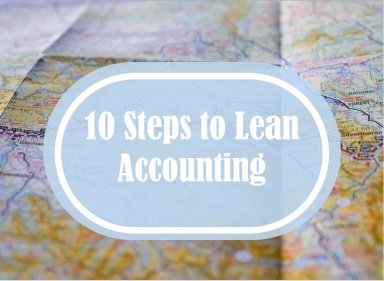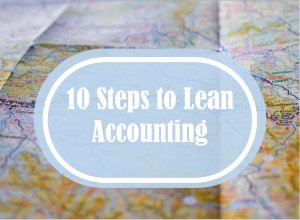
Publication number: ELQ-73875-1
View all versions & Certificate

How to Implement Lean Accounting
This step-by-step methodology provides 10 steps on how to implement Lean Accounting.
Introduction
The word is out: Lean Accounting is the wave of the future. Or is it?
Lean Accounting is the first really new concept in accounting in years, where key progress includes double-entry bookkeeping (Middle Ages), Standard Financial Statements (early Nineteenth Century), overhead allocation (early Twentieth Century), and Activity Based Costing (1980’s). And it is demonstrably better in its proper environment, producing a dramatically clearer picture of the enterprise for planning and operational control purposes. But what is it, and what is its proper environment?
How Lean Accounting is Different
In standard, full-absorption accounting, a primary task of accountants is to fix specific costs to every produced item. The costs are typically captured and tracked in units of raw, Work-in-Process (WIP), and finished goods inventories, and become Cost of Goods Sold (COGS) on the Profit and Loss Statement (P&L) as each unit is bought by a customer. Numerous transactions are processed daily to ensure that costs of materials and direct labor are assigned correctly and that production overhead costs are allocated as accurately as possible. That can be a lot of accounting.
By contrast, Lean Accounting focuses on all costs of “value streams” (start-to-finish work activities associated with individual product families). Because inventories are virtually eliminated or held very stable by in-line kanban rules, costs are streamlined and no longer tracked into and out of inventory. This significant work reduction frees accountants up for really productive work, helping company strategists focus on uses for available capacity (which typically increases dramatically in a lean environment) and helping line operators identify, prioritize, and capitalize on cost opportunities. Lean Accounting may not be less accounting, but it provides a lot more bang for the buck.
When to Consider Lean Accounting
At this writing, American productivity is reaching new heights at a dizzying pace, with industry leaders topping out at levels thought unachievable a few decades ago and fast followers catching up with gusto. Spearheading this activity are the theorists and practitioners of Lean Operations, who noticed early that production can be most profitable when it makes and delivers almost exactly what willing buyers want and almost exactly when they want it. In its purest form, this would be unique products and services created one at a time for individual customers at mass-production cost efficiencies.
Of course, and fortunately, there are marketers to run herd on the demand, ensuring that buyers can be found for high volumes of the same or very similar products. And there are still products which can be produced on lines that run three shifts every day for years. But for most products, shorter runs of a variety of products and features are the trend, and always more efficient following these principles of Lean Operations:
• Production is only to customer demand
• Each line station is signaled to produce by demand at the next station
• Inventory is greatly reduced throughout the process
So, what is the proper environment for Lean Accounting? In general, the more variety of product and process, the more often lines are stopped and started, the more a company will profit from Lean Operations. And the more a company gains by shifting to Lean Operations, the more it will gain from also shifting to Lean Accounting. The wave of the future? For many industries, the future has arrived.
Shifting to Lean Accounting
Because proper accounting is so critical and Lean Accounting is so different, it is important to proceed carefully, and generally takes several years to accomplish, primarily because year-end method shifts are the least disruptive. It is also important that the path to Lean Accounting be aligned with the progress toward a Lean Operating environment, which also generally takes months or years to achieve. The following Ten Steps describe a possible transition path.
- Step n°1 |
Evaluate Where You Are and Where You Want to Be
Using an evaluation system such as the Kaufman Global 20 Keys of Lean Accounting®, determine how much change your accounting system and processes will need to change. Based on planned progress toward a Lean Operating environment, develop a road map to ensure that your accounting system will support the environment and provide optimum benefit from the lean implementation. Begin to set executives’ and operating managers’ expectations, and to develop interim metrics to demonstrate the value of lean manufacturing. These will be critical because many lean benefits are masked by traditional accounting, and some (such as Cost of Goods Sold during periods in which inventory is reduced) may actually look worse! - Step n°2 |
Establish Implementation Principles
Accounting is accounting, and accountants are beholden to many masters. Generally Accepted Accounting Principles (GAAP) are defined and continuously updated by the Financial Accounting Standards Board (FASB). The Sarbanes-Oxley Act (SOX) requires controls and documentation to prevent fiscal abuses by corporations. And every company has its own set of planning, consolidation, and reporting requirements, defined by executive management and influenced by market analysts. The first step is to ensure that the requirements are understood, and particularly that inviolable rules are clear.
Beyond the inviolable rules within GAAP and SOX, though, there is considerable flexibility, and it is critical that executives understand the benefits and have appropriate expectations about Lean Accounting from the beginning, so that they can help establish the Principles to be followed in their specific implementation. An example of a set of Principles:
• Total compliance with GAAP
o All costs properly assigned to products [define how]
o All inventories appropriately valued [define how]
• Total compliance with SOX
o All control processes documented
o All audits current [plan how]
• Headquarters consolidation
o Monthly (or quarterly?) closing
o Monthly forecast
Profitability and cash flow
Value Stream statistics
Available capacity
o Operations improvement targets and progress - Step n°3 |
Establish Production-Oriented Metrics and Business Case Methodology
In the earliest stages of implementing Lean Operations, baselines are established for a variety of balanced objectives, such as First Pass Yield, On-Time Delivery, Available Capacity, and Production Units per Hour. Accompanying these metrics are such financial measures as inventory by category, unit cost, scrap and rework, and the like. Since the end objective of implementing a lean environment is total plant profitability, it will be important to prioritize improvement opportunities that attack the root causes of waste. Lean teams need accounting help to understand the underlying cost drivers, and to calculate and format business cases that clarify exactly what investments are required and as precisely as possible where improvements will show up. As Lean Accounting simplifies some accounting work, it will free up accountants increasingly to work directly with operating teams to optimize investments in operations improvements.

